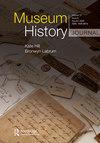Function or folly? Philip Johnson’s pavilion for pre-Columbian art in Washington DC
IF 0.2
Q3 HISTORY
引用次数: 1
Abstract
ABSTRACT Nestled within the gardens of Dumbarton Oaks in Washington DC is a modern pavilion for viewing art, designed by Philip Johnson in 1963. Johnson utilised a circular module organised into a three-by-three grid, with an open courtyard in the centre. Each module is encased by glass walls, as Johnson wanted to merge nature and architecture. The building is outfitted in a minimal palette of luxurious materials, with an aesthetic that pulls stylistically from Johnson’s travels. With no programmatic or budgetary constraints, Johnson was able to design conceptually, similar to his own projects where he designed small structures with little purpose, termed follies. Critically acclaimed yet lesser-known, the pavilion has not been analysed as a museum. As such, this article asks the question, is this structure merely a folly or does it function as a space to exhibit and view the pre-Columbian objects in the collection?功能还是愚蠢?菲利普·约翰逊在华盛顿特区为前哥伦布时期的艺术设计的展馆
坐落在华盛顿特区敦巴顿橡树园的花园中,有一座现代艺术观赏馆,由菲利普·约翰逊于1963年设计。Johnson使用了一个组织成三乘三网格的圆形模块,中心有一个开放的庭院。每个模块都被玻璃墙包围,因为约翰逊想要融合自然和建筑。该建筑采用了极简的奢华材料,其美学风格来自约翰逊的旅行。在没有规划或预算限制的情况下,Johnson能够从概念上进行设计,类似于他自己的项目,他设计了一些没有目的的小结构,称为follies。虽然广受好评,但知名度较低,但该展馆并未作为博物馆进行分析。因此,这篇文章提出了一个问题,这个结构仅仅是一个愚蠢的东西,还是它的功能是作为一个空间来展示和观看收藏中的前哥伦布时期的物品?
本文章由计算机程序翻译,如有差异,请以英文原文为准。
求助全文
约1分钟内获得全文
求助全文

 求助内容:
求助内容: 应助结果提醒方式:
应助结果提醒方式:


